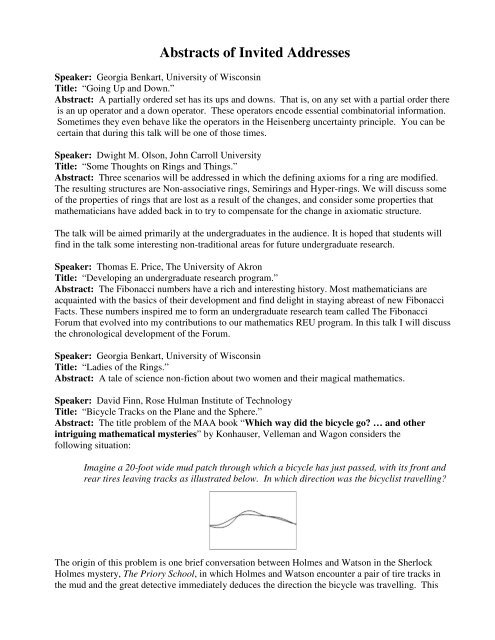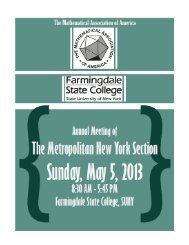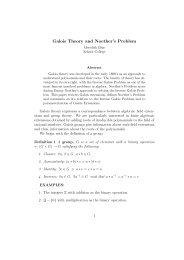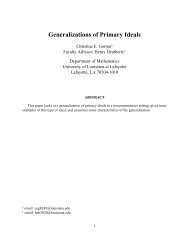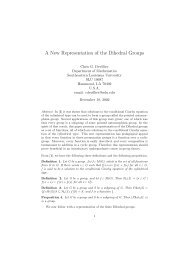Program - MAA Sections - Mathematical Association of America
Program - MAA Sections - Mathematical Association of America
Program - MAA Sections - Mathematical Association of America
Create successful ePaper yourself
Turn your PDF publications into a flip-book with our unique Google optimized e-Paper software.
Abstracts <strong>of</strong> Invited Addresses<br />
Speaker: Georgia Benkart, University <strong>of</strong> Wisconsin<br />
Title: “Going Up and Down.”<br />
Abstract: A partially ordered set has its ups and downs. That is, on any set with a partial order there<br />
is an up operator and a down operator. These operators encode essential combinatorial information.<br />
Sometimes they even behave like the operators in the Heisenberg uncertainty principle. You can be<br />
certain that during this talk will be one <strong>of</strong> those times.<br />
Speaker: Dwight M. Olson, John Carroll University<br />
Title: “Some Thoughts on Rings and Things.”<br />
Abstract: Three scenarios will be addressed in which the defining axioms for a ring are modified.<br />
The resulting structures are Non-associative rings, Semirings and Hyper-rings. We will discuss some<br />
<strong>of</strong> the properties <strong>of</strong> rings that are lost as a result <strong>of</strong> the changes, and consider some properties that<br />
mathematicians have added back in to try to compensate for the change in axiomatic structure.<br />
The talk will be aimed primarily at the undergraduates in the audience. It is hoped that students will<br />
find in the talk some interesting non-traditional areas for future undergraduate research.<br />
Speaker: Thomas E. Price, The University <strong>of</strong> Akron<br />
Title: “Developing an undergraduate research program.”<br />
Abstract: The Fibonacci numbers have a rich and interesting history. Most mathematicians are<br />
acquainted with the basics <strong>of</strong> their development and find delight in staying abreast <strong>of</strong> new Fibonacci<br />
Facts. These numbers inspired me to form an undergraduate research team called The Fibonacci<br />
Forum that evolved into my contributions to our mathematics REU program. In this talk I will discuss<br />
the chronological development <strong>of</strong> the Forum.<br />
Speaker: Georgia Benkart, University <strong>of</strong> Wisconsin<br />
Title: “Ladies <strong>of</strong> the Rings.”<br />
Abstract: A tale <strong>of</strong> science non-fiction about two women and their magical mathematics.<br />
Speaker: David Finn, Rose Hulman Institute <strong>of</strong> Technology<br />
Title: “Bicycle Tracks on the Plane and the Sphere.”<br />
Abstract: The title problem <strong>of</strong> the <strong>MAA</strong> book “Which way did the bicycle go? … and other<br />
intriguing mathematical mysteries” by Konhauser, Velleman and Wagon considers the<br />
following situation:<br />
Imagine a 20-foot wide mud patch through which a bicycle has just passed, with its front and<br />
rear tires leaving tracks as illustrated below. In which direction was the bicyclist travelling?<br />
The origin <strong>of</strong> this problem is one brief conversation between Holmes and Watson in the Sherlock<br />
Holmes mystery, The Priory School, in which Holmes and Watson encounter a pair <strong>of</strong> tire tracks in<br />
the mud and the great detective immediately deduces the direction the bicycle was travelling. This


